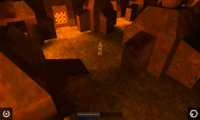Prospero
| The contents of this article have been cut. | ||
|---|---|---|
The subject matter of this article contains in-development information that was cut from the final version of an official and/or canonical source and appears in no other canonical source. It may also contain incomplete information since not all cut material is publicly known. |
| Prospero | |
|---|---|
| Developer(s) | |
| Release date(s) |
Cancelled |
| Genre(s) | |
| Mode(s) | |
| Platform(s) | |
Prospero[1] was one of Valve's first game designs, slated to come out shortly after Half-Life.[1]
Development[edit]
Work on Prospero began in late 1996, sometime after Valve Software was founded. The game was to emphasize exploration, an intricate storyline, and combat via "psionic" powers. Influences would have included the video game Myst and the works of Jorge Luis Borges. The protagonist of Prospero (known as "The Librarian", "Aleph", or "Aleph-Null", as the character was one of a set[2]) underwent a series of design changes during the early development of the game. One iteration relied heavily on the use of psionic amplifiers to augment her innate abilities.[1]
Another character, named Miranda, was created by Les Betterley,[3] who was an artist on the Prospero team and "was just coming up with art to get the creativity started." As stated by Marc Laidlaw, the character must have come from the original Prospero concept, which pre-dated his arrival, as he didn't know anything of it. The concept art shows her bearing a lambda tattoo on the left arm, a symbol, which eventually ended up being the Half-Life series' logo. Les Betterley said that it was his influence, and not something required. Moreover, Marc Laidlaw stated that it was never a Prospero logo.[2]
In July 1997 Laidlaw was hired. Although he was supposed to do "a couple weeks of work to consolidate the storyline for Half-Life so that it could ship that year", the bulk of his time was devoted to Prospero, which he called "a science fantasy epic."[4] Another developer, Karl Deckard, is known to have been involved in every level of the design process for the game from August 1996 to October 1998.[5]
As the design of Quiver started to take over some of Prospero initial goals, Prospero evolved into a massively multiplayer game. It was also intended to be distributed with a mix of official and user-created worlds that could be accessed through The Library, the core hub of the game, where the main character was in charge of the various world stored there;[2] each game would be running on its own server. Online distribution, server browser, a friend finder, user-created content and other concepts initially conceived for Prospero would eventually find their way into the Half-Life series, the Portal series,[5] Steam, and Valve's support of fan-made modifications.[1] As Half-Life proved to be an irresistible force, the Prospero team was soon absorbed.[4]
In June 2006, Gabe Newell stated that he would like to resume work on Prospero after Team Fortress 2 was completed.[6]
In mid-2014 several screenshots of the game, showing rough and unfinished environments created by Randy Lundeen as a means of establishing Prospero's sense of scale, were presented by ValveTime. Marc Laidlaw stated that "getting scale right was critical" as it was a third-person game, and that "in general, the blue-toned images are all from The Library." The warmer-colored, industrial locations, created by a level designer Duncan, were part of a world that the player would enter, which featured a furnace area that generated heat to turn the giant gears.[2]
Raising the Bar's uncorrected proof reveals a plot outline for the game. As described by Gabe Newell, The Library was under attack by an alien intelligence, and tried to create different versions of the main character - who had helped create The Library long ago - to defend itself. However, the resulting versions would become 'mad' and create more of the 'crazy, tall versions of you and scatter them around'. Eventually, The Library decides to brings back a version of the protagonist from a younger age, without any memories, and remove itself. From there, the protagonist must explore different worlds, find different versions of themselves, turn The Library back on, and defeat the invading force.[7]
Behind the scenes[edit]
"Prospero" is the Italian, Portuguese and Spanish version of the first name "Prosper", which comes from the Roman name "Prosperus", which means "prosperous", "fortunate" or "successful" in Latin.[8][9] The choice of the name may be a nod to the character Prospero, an island-dwelling duke in exile who could perform powerful magic, in Shakespeare's The Tempest; his daughter was known as Miranda. The name of the main character, Aleph is the name used by mathematicians, starting with Georg Cantor, to describe the sizes of infinite sets, named after the first letter of the Hebrew alphabet, with Aleph null being the smallest infinity. It is also a nod to Borges' short story The Aleph, in which he describes a point in space that contains all other points, and through which the entire universe can be seen, itself a reference to the mathematical usage.
In the Half-Life sound files folder (Steam version), the music files commonly known as "Dimensionless Deepness", "Steam in the Pipes", "Threatening (Short)", "Traveling Through Limbo" and "Vague Voices" are named "prospero01" to "prospero05". In the Half-Life 2 leak sound files, Breen can be heard mentioning the "Aleph universe", as an early name for the Combine Overworld.[10] Marc Laidlaw stated that "Aleph has a meaning that predates Prospero and Dr. Breen," and that there's no intentional overlap of the worlds of both games, though "all conceivable worlds could be pocket universes contained in the library."[2]
According to Karl Deckard, Aleph's duality of weapons and psionics became the duality of weapons and visors in Metroid Prime, ideas of user-created content influenced the in-game editor of Infamous 2 and Aleph's psionic amplifiers "were applicable" to skill runes in Diablo III."[11]
Gallery[edit]
References[edit]
- ↑ 1.0 1.1 1.2 1.3 Half-Life 2: Raising the Bar, page 10
- ↑ 2.0 2.1 2.2 2.3 2.4
 Prospero - Database: Episode 3 on YouTube
Prospero - Database: Episode 3 on YouTube
- ↑ Les Betterley's personal website
- ↑ 4.0 4.1 Marc Laidlaw On Story And Narrative on Gamasutra
- ↑ 5.0 5.1
 Karl Deckard on LinkedIn
Karl Deckard on LinkedIn
- ↑ Gabe Newell's FAQ - June 2006 at the Valve Developer Community
- ↑ Raising the Bar (Uncorrected Proof), p. 25
- ↑ Behind the Name: Prospero
- ↑ Behind the Name: Prosper
- ↑ Half-Life 2 leak
- ↑ Maine, Stuart (2022). "Interview with Karl Deckard". I’m Too Young To Die: The Ultimate Guide to First-Person Shooters 1992–2002. Bitmap Books. page 410.








